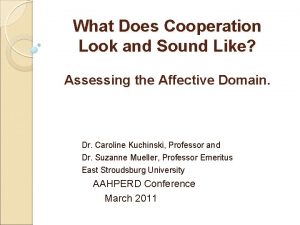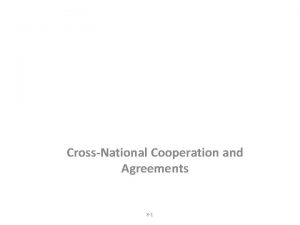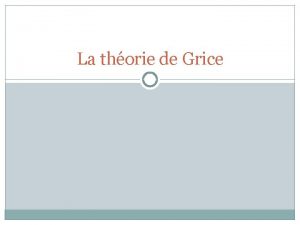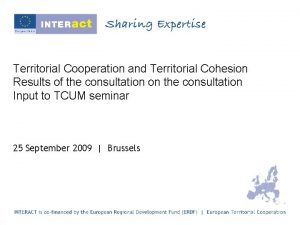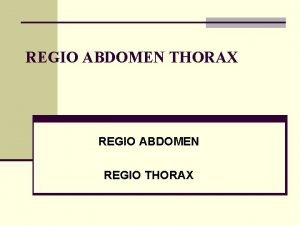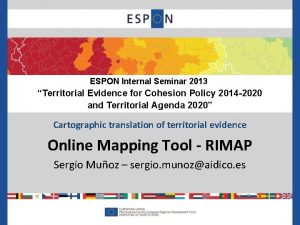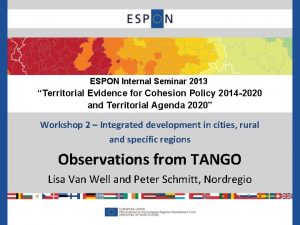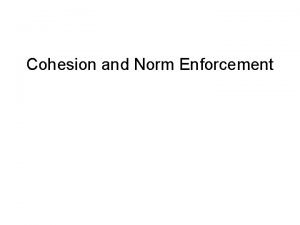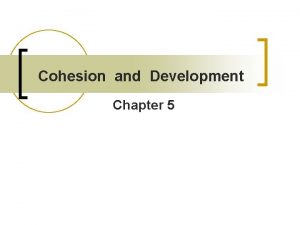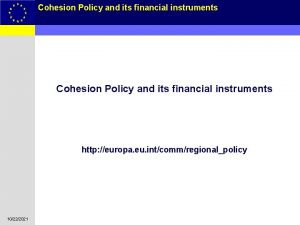DG REGIO Seminar Territorial Cooperation and Territorial Cohesion



























- Slides: 27


DG REGIO Seminar "Territorial Cooperation and Territorial Cohesion" Brussels 25 September 2009 Cross-border cooperation: 2 contributions from EU networks to the Green Paper on Territorial Cohesion n AEBR (Association of European Border Regions) n MOT (Mission Opérationnelle Transfrontalière) and EUROMOT

Cross-Border Cooperation (CBC) • • 50+ years of “formal” CBC; centuries of “informal” and “abnormal” CBC Laboratory for European Integration Central Europe (Rhine basin), Northern Europe, Mediterranean regions, Eastern Europe (Caucasus) Global CBC for Global Challenges

Map of the AEBR CBC regions in 2007

European Diversity Various: • Cultures and social systems • Administrative structures and powers • Fiscal and social legislations • Many other political activities • • • Citizens have grown up in different environments They will not sacrifice aspects of everyday lives No State will alter its tried and trusted structures

European Integration • Different identities, feelings, systems, etc… will collide at the borders in the years to come (diversity) • Common objective of the EU: from an economical alliance to a political entity

Day-to-day at border areas: Preliminary conclusions • • • The work made by Euroregions and similar structures can only be successful if supported by citizens and regional/local politicians from both sides of the border At the borders, the citizens deal with practical aspects of Europe every day (Laboratories for European Integration) There will be no regulation compatible with all countries (except EGTC)

Cross-border Cooperation (CBC) CBC has never been a national priority, but it is European task and EU political objective

Critical Mass • • CB regions cover half of their potential areas of influence CBC makes it easier to achieve a critical mass: synergies, efficiency, joint planning and management Creation of CB influence areas Creation of alliances for mutual and sustainable benefit: Co-operation means strength

AEBR Statement on the Green Book on Territorial Cohesion Definition. General Remarks n Cohesion is a policy for the whole territory of the EU, to use the different endogenous development potential of all European regions n Cohesion policy should contribute to territorial cohesion and deal with the new challenges (globalisation, demographic change, climate change, etc. ). But it is not the only instrument n CBC is an essential part of cohesion policy and a political objective by itself n Favourite example of European added value and territorial cohesion n Many border regions are not only affected by one, but by several negative characteristics

AEBR Statement on the Green Book on Territorial Cohesion Appropriate Definition of TC n n n Re-nationalization has to be rejected (decentralization downwards and upwards) Cohesion should reduce economic and social disparities and contribute to a harmonious development A balanced, harmonious and sustainable European territory: – Polycentric development with balanced opportunities between agglomerations / metropolitan areas and rural areas – A revised rural policy – Place-based approach (Barca) n n n CBC as its cornerstone European priority and political objective of the EU TC is closely connected to the configuration of spatial development TC as a horizontal objective (and challenge) TC requires coordination between different policies (integrated part) Proposed definition: “strategic political framework” for all related sectorial policies

AEBR Statement on the Green Book on Territorial Cohesion Additional elements to economic and social cohesion n Need to bring the citizens closer together n The EU as a community of values based on shared cultural, social, economic and political aims n There is a clear added value of territorial cohesion n An enlarged EU needs TC and a consistent implementation of the bottom-up principle with due regard for subsidiarity and partnership n TC strengthens the role of regional and local authorities and other actors n CBC is mostly affected by TC

AEBR Statement on the Green Book on Territorial Cohesion Scale and Scope of Territorial Actions: Promoting Cohesion by Subsidiarity TC through a future European Cohesion and Regional Policy. Effectively improved by the following measures: n Involvement of regional and local authorities. There should be defined clear rules to guarantee the role and responsibilities of the regional / local level in the implementation of EU-programmes n Simplification of administrative procedures and increased efficiency of organisational processes remains necessary n The Neighbourhood Programme and the ENPI should be brought back to the responsibility of the GD Regio n The EU legal instrument EGTC has to be improved by learning from lessons up to now

AEBR Statement on the Green Book on Territorial Cohesion Scale and Scope of Territorial Actions: Policy intervention according to type of problem n Global challenges and effects n A large-scale priority is necessary considering Europe as an integrated system. Incoherencies: – Raw materials supply and processing (energy sector, steel) in the EU – Mergers at European level – National competition in globally important technological development fields – Large-scale risk management n Lack of a Culture of Risk n New challenges have direct impact on border areas, especially if they are rural ones n Metropolitan areas / urban agglomeration and rural areas are mutually linked

AEBR Statement on the Green Book on Territorial Cohesion Scale and Scope of Territorial Actions: Special measures for geographic distinctions n n n n Diversity: equal vs. same treatment Regions with special problems CBC strongly related to territorial, economic and social cohesion 32% of the European population live in border areas, almost 40% of the enlarged EU territory EU programmes for CBC must also be applied Europe-wide for all border regions and solve all border problems CBC remains one of the few EU's instruments reaching citizens and regions in the enlarged Europe and realise subsidiarity and partnership CBC creates demonstrable added value Contributes to the implementation of the Lisbon Strategy, as always adds value to national measures due to: – – – – n Additionallity of CB programmes and projects, Synergies through CBC, Joint research and innovation, CB networking, Exchange of best practice and know-how, Spin-off effects by overcoming borders, Efficient CB resource management. Its potential is hardly exploited

AEBR Statement on the Green Book on Territorial Cohesion Better Cooperation: Role of the Commission n The regional / local level is most suitable to implement EU CB programmes and projects But long-lasting larger program units are tailored n One programme for each border, with independent subprogrammes per CB region n Decentralisation n Division between CBC, IRC and TNC n Higher flexibility is in contradiction to the strategic approach of the EU Structural Funds n one programme = one fund n The Nuts III level is still the best one for CBC, in general

AEBR Statement on the Green Book on Territorial Cohesion Better Cooperation: New Forms of Territorial Cooperation, I Based on the experience gained with Interreg A and Phare CBC, it is recommended: n The multiannual strategic and programmatic approach of CBC should be kept to assure co-financing over several years n CBC should be more decentralised in practice n Multilateral and / or large programmes that cover several borders have not been proved to be efficient or successful n Socio-cultural cooperation (including people-to-people activities) is just as important as economic and infrastructure development

AEBR Statement on the Green Book on Territorial Cohesion Better Cooperation: New Forms of Territorial Cooperation, II n Territorial Cooperation should obtain significant more funds after 2013 n CBC should obtain first political priority further on n Substantive criticism of Interreg A

AEBR Statement on the Green Book on Territorial Cohesion Better Cooperation: New Legislative and Administrative Instruments (also on the external borders) n n n “Multi-level Governance” Networks, partnerships and subsidiarity Crisis of Nation-State It is about instruments, not administrative levels of cooperation It is about execution of important tasks with suitable instruments, while the competences remain at the national, regional and local levels Avoid the terms “administration level” and “competence” Specific for external borders: n n n The EGTC should be better used also here Technical Assistance through benchmarking DG Relex - DG Regio

AEBR Statement on the Green Book on Territorial Cohesion Better Coordination: Between Territorial and Sectorial Policies n Territorial Agenda clearly requests to coordinate Member States’ policies, but also EU’s and between them n Better coordination between Cohesion Policy, other Community policies, and national policies n Stronger strategic approach, better allocation of responsibilities (not competences) and further decentralisation n Must include all essential areas of EU policies

AEBR Statement on the Green Book on Territorial Cohesion Better Coordination: Territorial Impact of Certain Sectorial Policies n Sectorial policies have to be reviewed regarding their spatial effects (transport, agriculture, education, …) n Other European policies with an even stronger macroeconomic and macro-territorial influence: – Strengthening competitiveness – Labour market policies – Rural areas policies

AEBR Statement on the Green Book on Territorial Cohesion Better Coordination: Coherence of Territorial Policies n Regional Policy, ESDP and Territorial Agenda n Political aims of Territorial Cohesion within the sectorial policies at European and national / regional level n Stronger attention to the national / regional / local policies and vice-versa n Better synchronization of EU sectorial policy areas

AEBR Statement on the Green Book on Territorial Cohesion Better Coordination: European-National combination At national level, better conditions for better combination can be provided, e. g. through: – Consideration of CB spatial development concepts in national spatial planning with the aim of a genuine region-specific planning across borders. – Inclusion of CBC structures at regional / local level in this planning on a regular basis – Transfer of tasks to such CBC structures – Facilitation of CB environment and risk management – Effective implementation of EGTC

AEBR Statement on the Green Book on Territorial Cohesion New Territorial Partnership: New Actors n Citizens’ participation n The regional / local level has proved to be the most appropriate to implement numerous EU programmes and projects with good results n Implementation of the bottom-up principle n From the very beginning, public authorities should involve all stakeholders, NGOs, etc. n All partners on board

AEBR Statement on the Green Book on Territorial Cohesion New Territorial Partnership: How? n Good and sustainable partnership between public authorities and private actors n Legal structures, based on interstate agreements, the EGTC or the Madrid Outline Convention, are (logically) limited to public authorities, but Private actors do not need a legal basis on public law n Legal structures for territorial cooperation, especially cross-border, take the responsibility for the overall cooperation as well as the financial liability n Private partners act within the limit of the working territory n Private actors will not and cannot take the overall responsibility n Thematic working groups n All actors of all sectors on both sides of the border have to be involved in this way in the CBC n Using existing knowledge

AEBR Statement on the Green Book on Territorial Cohesion Improving Understanding of TC: EU Quali- and Quantitative indicators n n Still too many single regulations Most important qualitative issues are not or only rather weak described Examples for qualitative indicators: – – – – – Existing Euroregion or similar structure Cooperation structure based on a legal instrument Duration of the cooperation structure Participation of social partners, NGOs, etc. CB activities outside Interreg A Degree of responsibilities for the management of EU programmes Involvement / participation in cross-programmes outside Interreg A Way of implementation and management of CB activities Type of projects (CB, mirror or single projects) Own CB financial resources – – – Number of new border crossings Kilometres of cross-border infrastructure Additional working places Additional tourists Additional innovation and research facilities Examples for physical indicators:

THANK YOU VERY MUCH FOR YOUR ATTENTION info@aebr. eu www. aebr. eu
 Agriculture cooperation and farmers welfare
Agriculture cooperation and farmers welfare What does cooperation sound like
What does cooperation sound like Cooperation interaction examples
Cooperation interaction examples International laboratory accreditation cooperation (ilac)
International laboratory accreditation cooperation (ilac) European co-operation for accreditation
European co-operation for accreditation Cooperation relationship ecosystem
Cooperation relationship ecosystem Offer for cooperation
Offer for cooperation Inter american accreditation cooperation
Inter american accreditation cooperation Asia-pacific economic cooperation forum
Asia-pacific economic cooperation forum Contractual brief
Contractual brief Cooperation in social interaction
Cooperation in social interaction Pic s member countries
Pic s member countries Archi visio
Archi visio Communication coordination cooperation during the emergency
Communication coordination cooperation during the emergency Blueprint for sectoral cooperation on skills
Blueprint for sectoral cooperation on skills Communication cooperation coordination collaboration
Communication cooperation coordination collaboration Apec food safety cooperation forum
Apec food safety cooperation forum Mutual cooperation agreement template
Mutual cooperation agreement template Cross national cooperation
Cross national cooperation Collaboration or cooperation
Collaboration or cooperation Economic cooperation examples
Economic cooperation examples Favored cooperation with the romans
Favored cooperation with the romans Library cooperation
Library cooperation Nis cooperation group
Nis cooperation group Implicature conventionnelle
Implicature conventionnelle Oecd gps
Oecd gps Joint management council
Joint management council Working group on international cooperation
Working group on international cooperation

